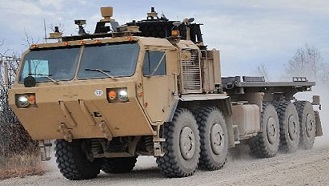 Recently, there has been a bit of press about a Capabilities Advancement Demonstration of autonomous vehicles at TARDEC (Tank-Automotive Research, Development and Engineering Center). My favorite headline about the demo so far is Is the U.S. developing a ROBOTIC army? (Daily Mail UK). Notice the attention-grabbing, alarm-generating capital letters for “ROBOTIC.”
Recently, there has been a bit of press about a Capabilities Advancement Demonstration of autonomous vehicles at TARDEC (Tank-Automotive Research, Development and Engineering Center). My favorite headline about the demo so far is Is the U.S. developing a ROBOTIC army? (Daily Mail UK). Notice the attention-grabbing, alarm-generating capital letters for “ROBOTIC.”
A somewhat more sober description can be found at Convoys of Driverless Trucks to Push Supplies to the Combat Zone (Defense Update). What was demonstrated was “… the ability of fully autonomous convoys to operate in urban environments with multiple vehicles of different models. The demonstration earlier this month at Fort Hood, Texas, was part of the Army and Marine Corps’ Autonomous Mobility Appliqué System (AMAS) program.”
The AMAS program grew out of a mandate Congress issued in 2000 that “…it shall be a goal of the Armed Forces to achieve the fielding of unmanned, remotely-controlled technology such that by 2015, one-third of the operational ground combat vehicles of the Armed Forces are unmanned.”
In the last 14 years, the fulfillment of this mandate has been intermittently pursued. Popular Science suggests that Lockheed Martin (an AMAS contractor) may be racing to get self-driving trucks to Afghanistan, so they can help with the withdrawal. Even a limited effort would give them real-world deployment bragging rights for this still-developing technology.
Here are some answers to basic questions about the recent demonstration and the ARMY’s unmanned vehicle effort in general.
What are AMAS’ goals?
A greatly simplified way of describing AMAS’ goal is to provide scalable autonomy in a single-material, vehicle-agnostic solution. Other goals are to define an open architecture for future autonomy enhancements and to produce an Analysis of Alternatives for testing large unmanned ground vehicles (UGVs).
However, AMAS goals should be understood in the context of its status as a Joint Capability Technology Demonstration (JCTD). JCTD is the ARMY’s standard procedure for demonstrating “…military utility of a significant new technology and an assessment to clearly establish operational utility and system integrity.” Neither an acquisition, nor a Science and Technology (S&T) program, JCTDs are intended to bridge the gap between the two. In other words, JCTD facilitates transition of new capabilities from developers to warfighters (end-users). The recent AMAS capability demonstration is a phase of JCTD.
As a JCTD, AMAS deliverables include:
- A demonstration of the technological application in a operational scenario,
- An assessment of the technology maturity and viability of pursuing further development efforts
- A proposal (if appropriate) for a plan for transition to an actual acquisition program
What was AMAS demonstrating?
For the demonstration, a variety of selected vehicles were implemented with By-Wire/Active Safety Kits (BWASK) and Autonomy Kits. BWASK provided electronically controlled subsystems and interface for the Autonomy Kit. As described above, the truck convoy was run through various real-world scenarios.
One hardware component that was demonstrated was the Unmanned Mission Module. In addition to a GPS, it contains LIDAR, which measures distance by illuminating a target with a laser and analyzing the reflected light. This enabled the unmanned trucks to successfully navigate intersections, traffic, pedestrians, and other obstacles. Similarity to sensor systems found on commercially developed autonomous cars is not coincidental.
Why was AMAS demonstrated at TARDEC?
TARDEC is the US Armed Forces’ R & D facility for advanced technology in ground systems. It is part of the Research, Development and Engineering Command (RDECOM), a major subordinate command of the United States Army Materiel Command. Numerous laboratories are found at TARDEC, including the Robotic Systems Integration Laboratory and Center for Ground Vehicle Development and Integration.
Why is AMAS important?
There are a number of autonomy efforts in development, but these kinds of efforts are noted for their glacial pace. In the opinion of some observers, AMAS is the one most likely to bear fruit within our lifetimes.
How can unmanned system providers get involved with AMAS?
AMAS is not a procurement program. Currently, no acquisition program exists for the Army’s initiative to install unmanned capabilities in their vehicle fleet.
The recent Capabilities Advancement Demonstration at TARDEC is a phase of JCTD process. Interested suppliers should watch out for the conclusion of the JCTD when the assessments and reports are written. This information will not be immediately made public, but it will determine if technology and operational doctrine supports initiation of an acquisition program with subsequent production.
If the acquisition program is green lighted, then interested suppliers should initiate the development of appropriate COTS variants for purposes of demonstration. The Army would rather buy modified COTS than fund more development programs.
It would also be a good idea for suppliers to do their homework. For more research on AMAS and JCTDs in general, see links below:
For his insights, many thanks to Rob Culver, AMREL’s Director of Business Development – DoD Programs. He can be reached at (603) 325 3376 or robertc@amrel.com.








